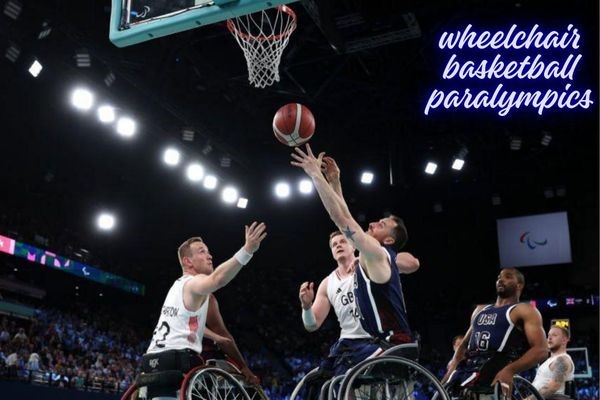Introduction: wheelchair basketball paralympics
Wheelchair basketball is one of the most thrilling sports at the Paralympic Games. It blends speed, sharp tactics, and teamwork, while also shining a light on the determination and talent of athletes with disabilities. Over the years, this game has evolved from a small rehabilitation activity for injured veterans into a high-intensity global competition that captures the attention of millions of fans.
In this detailed guide, we’ll explore the sport’s origins, rules, playing style, inspiring athletes, the “hibbies” (hobbies and interests) of players, and other fascinating details that make wheelchair basketball a standout Paralympic event.
Table of Contents
Origins and Growth of Wheelchair Basketball in the Paralympics
The roots of wheelchair basketball trace back to the late 1940s, when rehabilitation hospitals in the United States began encouraging injured soldiers—particularly those with spinal cord injuries—to play basketball as a form of physical therapy. What started as a way to boost recovery quickly turned into a passionate sporting activity.
By 1960, wheelchair basketball was officially introduced in the very first Paralympic Games in Rome. Since then, it has been a core event in every Paralympic edition, steadily growing in competitiveness, skill level, and global recognition.
How the Game Works
At first glance, wheelchair basketball looks much like traditional basketball, but there are some specific adaptations that make it unique.
The Court and Equipment
- Court Size: Same dimensions as standard basketball—28 meters by 15 meters.
- Hoop Height: Standard height of 10 feet (3.05 meters).
- Wheelchairs: Specially crafted sports chairs with slanted wheels for stability, lightweight frames for speed, and custom designs tailored to each player.
Gameplay Rules
- Teams: Five players per side on the court at one time.
- Dribbling: The ball must be dribbled after every two pushes of the wheelchair; otherwise, it’s considered a traveling foul.
- Player Classification: Each athlete is assigned a score from 1.0 to 4.5 based on functional ability—lower scores mean greater impairment. The combined total for all five players on court can’t exceed 14 points.
Key Skills and Playing Style
Wheelchair basketball demands a distinct blend of athletic and tactical skills:
- Upper Body Power: Strong arms, shoulders, and core are essential for both movement and shooting.
- Chair Handling: Players need to spin, stop, and accelerate smoothly, even in tight spaces.
- Accurate Passing and Shooting: Precision under pressure is vital, especially when opponents block using their chairs.
- Strategic Thinking: Positioning, teamwork, and reading the opponent’s moves are crucial to success.
The Paralympic Stage for Wheelchair Basketball
Men’s and Women’s Competitions
Both men’s and women’s tournaments take place at the Paralympics, typically starting with group stages before moving to high-stakes knockout rounds.
Leading Nations in the Sport
- United States – Renowned for producing dominant teams and home to some of the best professional wheelchair basketball leagues.
- Canada – Consistently strong, with smart and disciplined gameplay.
- Australia – Known for physical play and aggressive offense.
- Netherlands – Leaders in women’s wheelchair basketball.
Notable Paralympic Wheelchair Basketball Players
- Patrick Anderson (Canada) – Often hailed as the sport’s GOAT, with unmatched shooting accuracy and leadership.
- Becca Murray (USA) – A key figure in women’s wheelchair basketball, bringing home multiple Paralympic medals.
- Terry Bywater (Great Britain) – A veteran who’s been a scoring threat across several Paralympic Games.
Hibbies of Wheelchair Basketball Athletes
While their skills on the court are remarkable, Paralympic wheelchair basketball players lead vibrant lives outside the sport.
Creative Passions
- Many enjoy music, playing instruments such as guitar or drums during their downtime.
- Photography is a common hobby, especially for athletes traveling around the world for tournaments.
Staying Active Beyond Basketball
- Some athletes take part in other adaptive sports like handcycling, rowing, or swimming.
- Outdoor hobbies such as camping, fishing, and adaptive hiking help them relax between training sessions.
Advocacy and Mentorship
- A number of players use their platform to promote accessibility and inclusivity in sports.
- Many mentor young athletes with disabilities, inspiring the next generation of Paralympic hopefuls.
Interesting Facts About Wheelchair Basketball
- Not All Players Use Wheelchairs Daily – Some athletes can walk short distances but require a wheelchair for competition.
- Custom Wheelchair Designs – These high-performance chairs are built for speed, agility, and stability, and can cost several thousand dollars.
- Incredible Speed – Elite players can reach up to 20 km/h during a game.
- A Prestigious Medal – A Paralympic gold in wheelchair basketball is the ultimate achievement in the sport.
Training for the Paralympics
Physical Conditioning
- Strength Training: Focusing on shoulders, arms, and core stability.
- Cardio Workouts: Using arm ergometers and on-court sprints.
- Skill Drills: Sharpening shooting, passing, and defensive positioning.
Mental Preparation
- Studying Opponents: Watching match footage to identify weaknesses.
- Visualization: Mentally rehearsing plays to build confidence.
- Team Bonding: Strengthening communication and trust within the squad.
The Energy of a Paralympic Wheelchair Basketball Game
The buzz in the arena is unforgettable—squeaking wheels, rapid ball movement, fast breaks, and the roar of the crowd create a high-energy environment. Games are fast-paced, unpredictable, and often decided in the final seconds.
Challenges Faced by Athletes
Even with the sport’s growth, wheelchair basketball players still encounter challenges:
- Funding – High-quality sports wheelchairs and international travel are costly.
- Facility Access – Not all gyms are equipped for wheelchair sports.
- Media Exposure – Paralympic sports still receive less coverage than their Olympic counterparts.
Looking Ahead: The Future of Wheelchair Basketball
With technology improving sports wheelchair design, more nations investing in adaptive sports, and media coverage expanding, the future is bright for Paralympic wheelchair basketball. Young talent is emerging globally, promising exciting games and intense rivalries in upcoming Paralympic editions.
Final Thoughts
Wheelchair basketball is far more than just a sport—it’s a showcase of perseverance, talent, and unity. From its origins as a rehabilitation exercise to becoming one of the most celebrated Paralympic events, it has inspired people worldwide.
The “hibbies” of these athletes—whether music, photography, outdoor adventures, or advocacy—reveal the depth and diversity of their lives beyond the court. Their dedication to the game and their impact off it continue to break barriers, proving that sports have the power to change perspectives and bring people together.



